- Offensive Techniques & Strategies
Successfully Attacking Zone Defenses
What to Discover or Recall:
Discover that no two zones are the same, even if their basic alignments start out the same.
Explore the basic components that comprise a successful zone attack.
Learn that during a game that the coach must be attentive and instantly recognize various zones alignments along with their specific strengths and weaknesses.
Understand the common mistakes made against zone defenses,
Understand the "Don'ts" in attacking zone defenses.
Although their zone alignments may start out the same, no two zones are the same. Each zone defense has its own unique characteristics. They will vary according to a team’s player personnel and shifting abilities. Therefore, coaches cannot just be a spectator and watch the ball during the game. They must be alert and attentive. They must be able to instantly recognize the various zone alignments and be able to analyze their specific strengths and weakness.
| Zone Weaknesses | Attacking Zones | Reads & Counters | Common Errors | Zone Don'ts |
Various Zones Strengths & Weaknesses
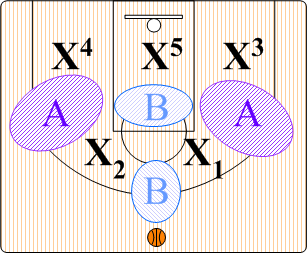
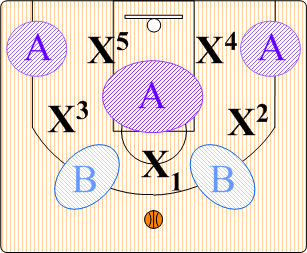
2 - 3 Zone
Major strength along baseline and low post.
Major weak spots wings and middle.1 - 2 - 2 Zone
Major strength outside shooting.
Major weak spots middle and corners.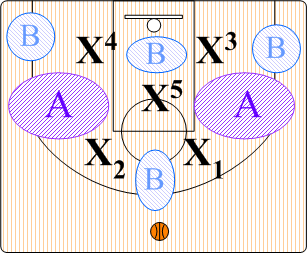
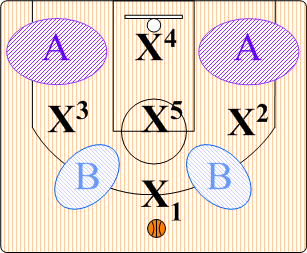
2 - 1 - 2 Zone
Major strength middle and low post.
Major weak spots wings and center of floor.1 - 3 - 1 Zone
Major strength across free throw line and down middle.
Major weak spots corners.

Principles for Penetrating Zone Defenses
Ball Movement
Sharp accurate passing is a key ingredient in attacking any zone defense. Make the zone defense work by moving the ball from sideline to sideline. Good ball movement increases the chances of defensive break downs and results in good shots. Incorporate skip passes, post feeds, and pump fake passes. Pass to the open player. Do not force the ball or make difficult passes. Pass to a specific target away from the defense. Do not pass to any player that does not call for or want the ball. Eliminate dribbling especially the trap or one bounce dribble which allows the zone to recover and match up.
Push the Ball
Beat the defense down the court. Keep head and eyes up and pass the ball ahead. Most zone defenses are susceptible to fast breaks. However, this is mainly due to the fact that teams do not work on defensive transition rather than playing zone defense. Also, by pushing the ball it will force the opponent to get back on defense rather than going to the offensive boards. If a good shot is not available on the early break flow directly into your zone offense.
Attack Post Defenders
Must establish an inside threat. Get the ball inside to the post whenever possible. Play your best offensive post player in low to take advantage in that most zone defenders play behind when guarding the low post area. When the zone collapses in order to protect the middle, it opens up outside shots for your spot up shooters.
Note: Inside players that find it difficult to get open against aggressive person to person defense usually find it much easier to get open and score against zone defenses.
Outside Shooting
Good outside shooting will definitely hurt any zone especially with the help of the three point shot line. Without it you could be in for a long season. However, outside shooters need to spot up in open areas, facing the basket ready to receive the ball and shoot. They should be alert for cross court skip passes and kick out passes from the post.
Dribble Penetration
Zones are weak in the seams and gaps. Dribble penetration into a seam will not produce a good shot. However, in splitting the defense, it will draw two defenders to the ball creating wide open shots off kick out passes. Ballhandlers should be careful to avoid offensive fouls.
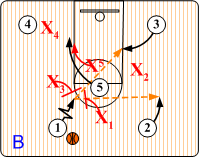
Rebound Offensively
Players also need to be aware of the zones rebounding weaknesses. Since in a zone defenders are assigned areas to rebound rather than individual players to box out, it gives the offense a real opportunity to get inside and block the defenders out on missed shots. Also, be sure to attack the side of the zone where the strongest rebounders are located. You want the opponent’s best rebounders on ball side guarding the ball rather than on the weakside where they can rebound.
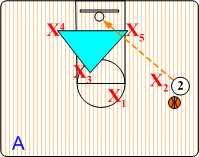
Rebounding Triangle
Assume all shots are going to me missed and establish TWO offensive rebounds on weakside.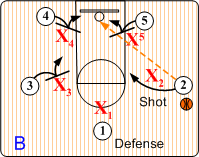
Box Out Offensively
During "Flight Time" the offensive rebounds should strive to establish inside position and box out the defensive rebounders.

Basic Zone Reads & Counters
In every type of zone there are some shifts that are difficult. These are the shifts you what your players to be aware of and exploit. Against man to man defenses, players are expected to "read" and counter defensive deployment. However, when it comes to zone defenses, players cannot be expected to "read" the defensive deployment since it involves analyzing the movement of all five defensive players. It is the coach's or an assistant coach's responsibility to constantly analyze and make adjustments against zone defenses.
Analyzing and Attacking Zone Shifts & Weaknesses
| 2-3 (2-1-2) Zones | 1-2-2 (3-2) Zones | 1-3-1 Zones |

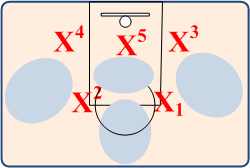
2-3 (2-1-2) Zone Reads & Counters
The 2-3 zone is strong along the baseline, but are very vulnerable to outside shooting.
Things to Watch For
Watch the basic shifts of the baseline players. Can they cover the wings?
Do they contest post feeds? How do they cover the middle?
How fast do they rotate and closeout on ball reversals?
Attacking the Wings
Covering the weakside wing is a problem of two three zone. Usually a baseline player will step out and show until the guard can shift over; and then recovers back to the baseline. This vulnerability should be exploited. Since this shift involves different players on each side of the court, you want to attack the side which the show & recover shift is the weakest.
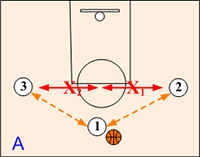
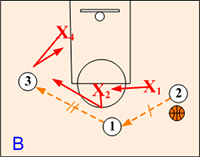
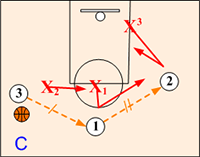
Place your best shooters on the wings. Observe how the opponent is covering the wings. Do they rely on their two outside players? Do they rotate out a baseline players to cover the wings? Which baseline player rotates out the slowest? How quick do they rotate and recover? You want to attack the side of the weakest wing rotations.
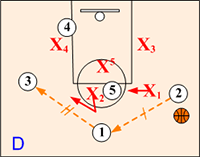
Anytime the baseline defender stays or is slow moving out, it creates a good opportunity for an open spot up three point shot.
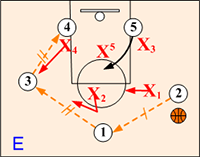
If/when the baseline player rotates out to cover the wing, it opens up the low post area for an easy inside shot.
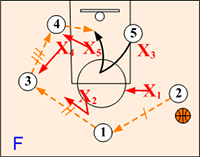
When the middle defender drops to help out against the baseline player, it opens up a post roll to the basket.
Out Numbered Situation
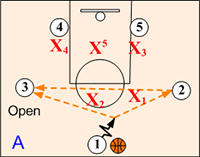
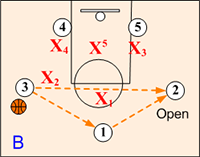
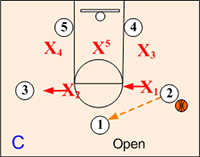
When the opponent keep their baseline players inside and cover the wings with just their outside players, play three on two and move the ball. Maintain proper spacing. When defender X2 covers the point O1 and X1 covers O2, it leaves O3 wide open. If X2 guards O3 and X1 moves over to cover O1, it leaves shooter O2 open. If/when X1 and X2 stay out on the wings it opens up O1 at the top of the circle.
Post Ups
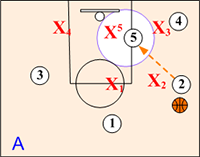
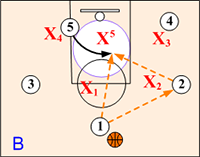
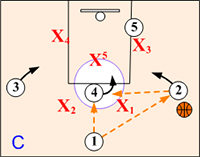
Although the 2-3 zone alignment appears to be strong in the middle, the real strength is contingent on the defender and not the alignment. Analyze the defensive ability and capability of the middle defender. Can they be readily posted up? How do they cover flashes into the middle? How do they match up against a high post.
The majority of zone post defenders play upright and behind. They do a poor job of contesting post feeds and passing lanes. When the defense plays behind, the offensive post is going to score, get foul or both. Isolate the middle defender by moving your best offensive post inside and get them ball.
Offensive Rebounding & Second Efforts
Determine which of the two baseline defenders is the weakest rebounder. Can you take offensive rebounding advantage of them by creating a mismatch by placing a strong rebounder on that side? Attack the side of the strongest rebounder. It is better to have them playing on ballside or guarding a shooter rather than being on the weakside in position to rebound.
Offensive Alignments
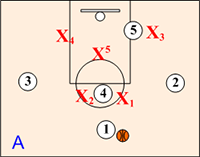
1-3-1 Alignment
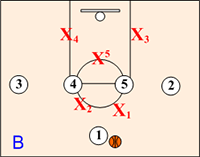
1-4 Alignment
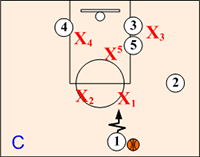
Stack Alignment
How will the 2-3 zone match up against the above offensive alignments?

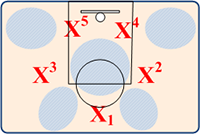
1-2-2 (3-2) Zone Reads & Counters
The three two or 1-2-2 zone is strong against outside shooters. However, it is weak in the middle and in the corners where their two baseline players have to guard corner to corner.
Things To Watch For
1-2-2 zones weak are vulnerable to inside and baseline attacks.
Watch the basic shifts of the two baseline players. Can they cover the corners?
Do they contest low post feeds?
How do they cover the middle? How fast do they rotate and closeout on ball reversal?
Strong Post Ups
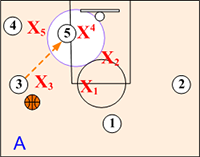
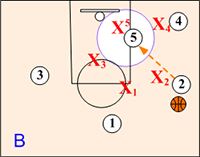
The majority of zone post defenders play upright and behind. They do a poor job of contesting post feeds and passing lanes. Attack the weakest of the two baseline defenders. Move your best post up player to that side of the court. Get the ball inside. When the defense plays behind, the offensive post is going to score, get foul or both.
Attacking the Middle
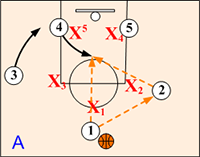
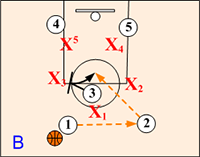
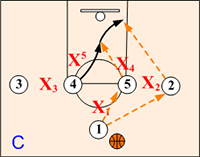
The 1-2-2 zone has a big hole in the middle. Observe how the opponent is protecting the middle. Do they rely on their baseline players? Do they collapse their outside players opening up skip passes and outside shots? How do they defend post flashes and high post alignments?
Corner Shots
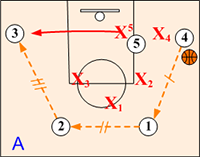
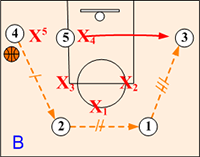
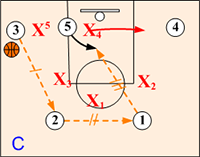
1-2-2 zone is very susceptible to corner shots. Watch the baseline defenders. How do they close out on corner shots? How fast do they recover back into the low post area? Attack the weakest player by placing your best corner shooter on that side of the court. Peripheral passers should also be alert to baseline rotations. Any time a defender is slow in recovering back into the low post area it opens up an opportunity for an easy inside shot.
Wing Drops
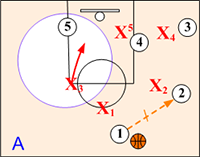
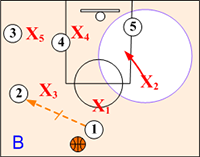
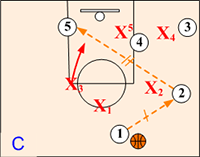
Observe how the wing defenders shift. Do they drop all the way to the baseline? Do they close out quickly? In a 1-2-2 zone, when the ball is on wing or in corner, the weakside wing drops to the baseline and has primary rebounding responsibility. Determine which of the defensive wings is the smallest and weakest rebounder. Can you take offensive rebounding advantage of them by creating a mismatch by placing a big player on the weakside boards? Also, be alert for the cross court or "X" pass opportunity when the weakside wing does not drop or is slow in dropping to the baseline
Offensive Rebounding & Second Efforts
Determine which of the baseline defenders is the weakest rebounder. Can you take offensive rebounding advantage of them by creating a mismatch by placing a strong rebounder on that side? Think about attacking the side of the court that the strongest rebounder is positioned. It is better to have them playing on ballside or guarding a shooter rather than being on the weakside in position to rebound.
Offensive Alignments
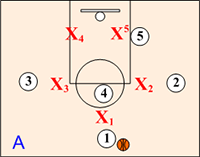
1-3-1 Alignment
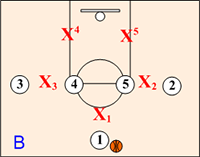
1-4 Alignment
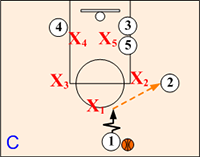
Stack Alignment
How will the specific 1-2-2 zone match up against various offensive alignments?

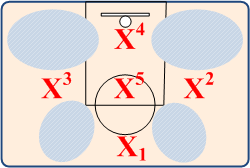
1-3-1 Zone Reads & Counters
The 1-3-1 zone is strong down the middle and across the free throw line extended. However, they are vulnerable to baseline and corner shots.
Things to Watch For
Watch the shifts of the baseline player. Does one player cover both corners or do they alternate with the high post player?
Do they contest low post feeds?
Can they handle high post rolls?
How fast do they rotate and closeout on ball reversal?
Attacking the Baseline
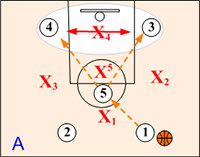
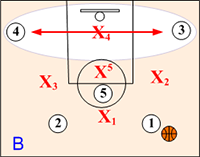
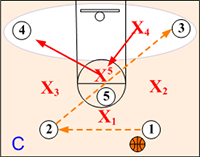
Watch the basic shifts of the baseline player. Can they cover the corners? Do they rely on one player to cover both corners? Do the middle and baseline defender switch roles on ball reversals? If so, does it makes them vulnerable in the middle? Do they employ wing drops to cover the corner? Place your best shooters in the corners and attack the side of the weakest rotations.
Post Ups
Although the 1-3-1 zone alignment appears strong in the middle, the real strength is contingent on the defender and not the alignment. Analyze the defensive ability and capability of the baseline defender. Can they be readily posted up? How do they cover flashes into the middle? How do they match up against a high post?
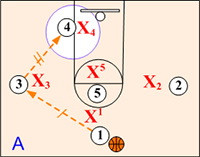
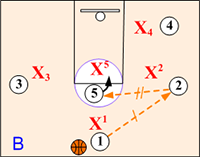
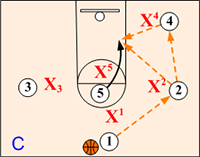
The majority of zone post defenders play upright and behind. They do a poor job of contesting post feeds and passing lanes. when the defense plays behind, the offensive post is going to score, get foul or both. Isolate the middle defender by moving your best offensive post inside and get them ball.
Baseline Screens
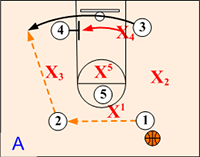
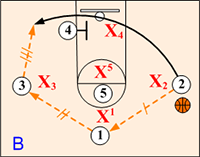
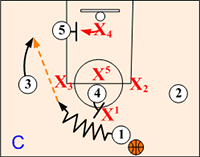
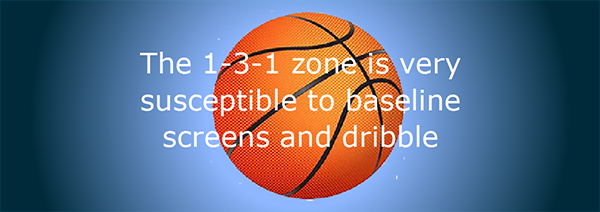
High Post Entry and Skip Passes
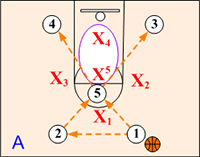
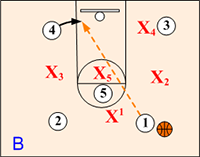
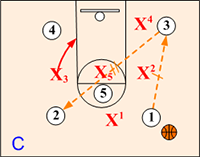
How do they cover the middle? Do they contest high post feeds? The 1-3-1 Zone also has problems matching up against a 2-1-2 offensive alignment. Anytime the ball is passed into the high post it immediately creates a three on two situation and the post should look to feed the open player on the baseline. The skip pass is also an import weapon. Players should constantly be looking to make a skip pass to the opposite corner especially when in trouble. Against a 1-3-1 zone the opposite corner will be always open.
Ball Reversals
Ball reversal is a key to attacking the baseline. Observe how the weakside wing shifts. Do they drop all the way to the baseline? How quick do they rotate and closeout? In a 1-3-1 zone, when the ball is on wing or in corner, the weakside wing drops to the baseline and has primary rebounding responsibility. Determine which of the defensive wings is the smallest and weakest rebounder. Can you take offensive rebounding advantage of them by creating a mismatch by placing a big player on the weakside boards? Also, be alert for the cross court or skip pass opportunity when the weakside wing drops to the baseline.
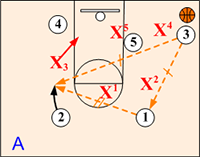
When the weakside wing defender drops down to the baseline, it opens up an opportunity for quick ball reversal or a skip pass to open O2.
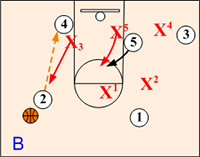
If the wing recovers to the ball, it opens up the low post area for an easy inside shot.
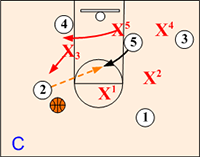
When the middle defender drops to help out against the baseline player, it opens up the middle of the zone.
Offensive Rebounding & Second Efforts
Determine which of the baseline defenders is the weakest rebounder. Can you take offensive rebounding advantage of them by creating a mismatch by placing a strong rebounder on that side? Think about attacking the side of the court that the strongest rebounder is positioned. It is better to have them playing on ballside or guarding a shooter rather than being on the weakside in position to rebound.
 Offensive Rebounding Techniques
Offensive Rebounding TechniquesOffensive Alignments
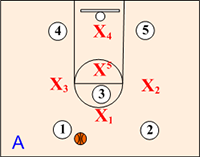
2-1-2 Alignment
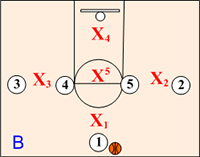
1-4 Alignment
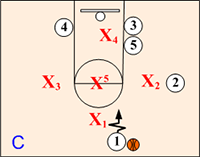
Stack Alignment
How will the specific 1-3-1 zone match up against the above offensive alignments?

Common Errors Made Against Zone Defenses
Not organizing quickly, by delaying to getting to offensive positions.
Not having patience and spreading the floor.
Bouncing the ball (trap dribble) before passing or shooting.
Not faking or looking off receivers before passing.
Not splitting the defensive alignment, therefore, making it easier for the zone to match up.
Not passing the post into the post.
Not reversing the ball and attacking the weakside of the zone.
Relying too much on outside shooting.
Poor shot selection (forcing or hurrying shots).
Lack of offensive rebounding effort.

Zone Offense - Don'ts
Do not hurry. Have patience and spread the zone.
Do not telegraph passes. Look off the receivers.
Do not lob the ball. Use sharp, crisp passes.
Do not throw one handed passes.
Do not throw to the same receiver every time.
Do not forget to pass the ball inside.
Do not trap dribble.
Do not match up or stand behind defensive players. Move to the gaps in the zone.
Do not give up the ball if unguarded.
Do not forget to rebound.
Return to Game Preparation - Click Here
Return to Coaching Strategies - Click Here
Return to HoopTactics - Click Here>
© 2025 HoopTactics All Rights Reserved.
